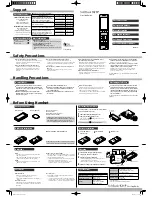
Copyright 2010-2015 Obihai Technology, Inc.
51
SIP/SP Service
Up to
6
SIP/SP service accounts can be configured on the OBi Phone. For the purpose of this and other OBi documents
and web pages, including the OBiTALK web portal, the term ITSP is used generically to describe the logical entity
providing the SIP Trunk service to the OBi. ITSP stands for Internet Telephony Service Provider. When the OBi1000 is
used with an IP PBX for instance, it should be understood that the ITSP refers to the IP PBX in this context.
Each ITSP configuration is grouped together as an ITSP Profile. There are
6
ITSP profiles available and we refer to them
as ITSP Profile A, B, C, D, E, and F respectively. The SP service account specifics on the other hand are grouped under
the heading SP
n
Service, where
n
= 1, 2,…, 6. An ITSP Profile includes such parameters as
ProxyServer
,
OutboundProxy
, and
DigitMap
, but does not include account specific parameters. An SP Service includes account
specific parameters such as
AuthUserName
(usually but not necessarily the same as the phone number of the
account),
AuthPassword
,
CallerIDName
, and
X_ServProfile
(which ITSP Profile to apply the ITSP specific
parameters from). If both SP Services use the same ITSP, it is usually possible to configure just one ITSP Profile with
both SP Services referring to the same profile. However if abstraction of an ITSP Profile is not sufficient to cover a
particular ITSP, it is perfectly alright to configure multiple ITSP profiles for the same ITSP and have each individual SP
service using that ITSP point to a different ITSP profile.
The SP
n
Service using ITSP Profile
X
is considered as
enabled
by the phone only if at least the following parameters are
set:
ITSP Porfile X – SIP
::
ProxyServer
=
Not Blank
SPn Service
::
Enabled
=
true
(or
checked
on the device web page)
SPn Service
::
AuthUsername
=
Not Blank
Where
X
= A, B, C, D, E, or F, and
n
= 1, 2, …, or 6. Otherwise the phone considers the service disabled.
SIP Registration
Device can be setup to periodically register with the
ProxyServer
or the
RegistrarServer
by enabling the
parameter
SPn Service
::
X_RegisterEnable
.
ProxyServer
and
RegistrarServer
could be different, although they
are rarely so in practice.
ProxyServer
is a required parameter that must be configured on the OBi device, while
RegistrarServer
is optional and is assumed to be the same as the
ProxyServer
if not specified in the configuration.
Note that if the server is not listening at the standard port, the correct port value must be configured in
ProxyServerPort
(and
RegistrarServerPort
as needed).
The main purpose of registration is to create and maintain a dynamic binding of the SIP/SP account to the device’s local
contact address. Service provider can also rely on this periodic message to infer if the device is online and functional.
Each OBi device takes only one local IP address that is either statically assigned in the device’s configuration, or
dynamically obtained from a local DHCP server, or through PPPoE. The method to use to get an IP address assigned is
determined by the value of
WAN Settings
::
AddressingType
. The SP
n
services for
n
= 1 – 6 on the other hand each
uses a different local contact port for sending and receiving SIP messages (default is 5060, 5061, 5062, …, and 5065
respectively). This port can be configured in the
SPn Service
::
X_UserAgentPort
parameter.
ProxyServer
and
RegistrarServer
must use the same transport protocol for SIP messages that can be set in the
ProxyServerTransport
parameter. The OBi1000 supports UDP, TCP, and TLS for SIP transport. The default server
port is 5060 for UDP/TCP and 5061 for TLS. When TCP/TLS is used, the OBi1000 will initiate a TCP/TLS connection only
with the
ProxyServer
; all subsequent SIP message exchange between the phone and the servers MUST use the same
connection. If for any reason the connection is closed, the phone will attempt to re-establish the connection following
an exponential backoff retry pattern.
Note that dynamic address binding through periodic registration is not strictly necessary if the local IP address of the
device does not change; the device’s contact address may be statically configured on the Registration Server.
Here is a typical REGISTER request generated by the phone:
















































